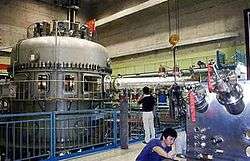Experimental Advanced Superconducting Tokamak
 | |
| Type | Tokamak |
|---|---|
| Operation date | 2006– |
| Major radius | 1.85 m |
| Minor Radius | 0.45 m |
| Magnetic field | 3.5 T |
| Heating | 7.5 MW |
| Plasma current | 1.0 MA |
| Location | Hefei, China |
| Experimental Advanced Superconducting Tokamak | |||||||
| Chinese | 先进超导托卡马克实验装置 | ||||||
|---|---|---|---|---|---|---|---|
| Hanyu Pinyin | xiānjìn chāodǎo tuōkǎmǎkè shíyàn zhuāngzhì | ||||||
| Literal meaning | Experimental Advanced Superconducting Tokamak | ||||||
| |||||||
The Experimental Advanced Superconducting Tokamak (EAST), internal designation HT-7U) is an experimental superconducting tokamak magnetic fusion energy reactor in Hefei, China. The Hefei-based Institute of Plasma Physics is conducting the experiment for the Chinese Academy of Sciences. It has operated since 2006. It was later put under control of Hefei Institutes of Physical Science.
It is the first tokamak to employ superconducting toroidal and poloidal magnets. It aims for plasma pulses of up to 1000 seconds.
History
The project was proposed in 1996 and approved in 1998. According to a 2003 schedule,[1] buildings and site facilities were to be constructed by 2003. Tokamak assembly was to take place from 2003 through 2005.
Construction was completed in March 2006 and on September 28, 2006, "first plasma" was achieved.
The reactor is an improvement over China's first superconducting tokamak device, dubbed HT-7, built by the Institute of Plasma Physics in partnership with Russia in the early 1990s.
According to official reports, the project's budget is CNY ¥300 million (approx. USD $37 million), some 1/15 to 1/20 the cost of a comparable reactor built in other countries.[2]
Operations and results
On September 28, 2006, "first plasma" was achieved.
By Jan 2007 "the reactor created a plasma lasting nearly five seconds and generating an electrical current of 500 kilo amperes".[3]
By May 2015 it was reporting 1 MA currents, and H-mode for 6.4 seconds.[4]
In February, 2016, a plasma pulse was maintained for a record 102 seconds at approximately 50 million Kelvin.[5] Plasma current of 400kA and a density of about 2.4 x 1019/m3 with slowly increasing temperature.[5]
In November 2, 2016, China has been able to successfully obtain high-confinement nuclear reactor plasma for a whole minute, which experts believe will promote the development of international thermonuclear fusion research. The reactor was able to maintain a temperature of 50 million Kelvins, that’s three times as hot as Sun’s core.[6]
Physics objectives
China is a member of the ITER consortium, and EAST is a testbed for ITER technologies.
EAST was designed to test:
- Superconducting Niobium-titanium poloidal field magnets, making it the first tokamak with superconducting toroidal and poloidal magnets
- Non-inductive current drive
- Pulses of up to 102 seconds with 0.5 MA plasma current
- Schemes for controlling plasma instabilities through real-time diagnostics
- Materials for diverters and plasma facing components
- Operation with βN = 2 and confinement factor H89 > 2
Tokamak parameters
| Toroidal field, Bt | 3.5 T |
| Plasma current, IP | 1.0 MA |
| Major radius, R0 | 1.85 m |
| Minor radius, a | 0.45 m |
| Aspect ratio, R/a | 4.11 |
| Elongation, κ | 1.6–2 |
| Triangularity, δ | 0.6–0.8 |
| Ion cyclotron resonance heating (ICRH) | 3 MW |
| Lower hybrid current drive (LHCD) | 4 MW |
| Electron cyclotron resonance heating (ECRH) | None currently (0.5 MW planned) |
| Neutral beam injection (NBI) | None currently (planned) |
| Pulse length | 1–1000 s |
| Configuration | Double-null divertor Pump limiter Single null divertor |
References
- ↑ Project/6.doc
- ↑ "China to build world's first "artificial sun" experimental device". People's Daily Online. 2006-01-21.
- ↑ Xinhua article Jan 15, 2007 Chinese scientists conduct more tests on thermonuclear fusion reactor. 2007-Jan-15
- ↑ EAST at IPP-CAS
- 1 2 "That's cute, Germany – China shows the world how fusion is done". more data in screen shot
- ↑
- ↑ "EAST (HT-7U Super conducting Tokamak)----Hefei Institutes of Physical Science, The Chinese Academy of Sciences".
External links
- Chinese Academy of Sciences Institute of Plasma Physics - EAST
- People's Daily article
- Xinhua article Mar 1 2006 - Note that EAST is not the "world's first experimental nuclear fusion device".
- Xinhua article Mar 24, 2006 Nuke fusion reactor completes test
- Mainichi Daily News article Jun 2, 2006